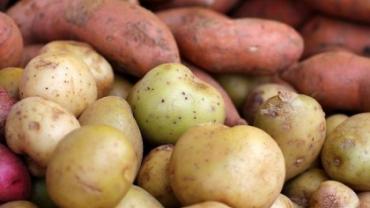
White potatoes are a beloved American side entrée and highly touted “vegetable” with the strange ability to provoke hostile reactions when elimination is suggested. We can remove the soda the candy bars the fast food and even the pasta but… not the potatoes! Perhaps it is the comfort food status or the fact that potatoes offer the choice of an inexpensive filler. Regardless these addictive tubers beg for an adequate explanation of their inferior role in health-promoting lifestyles.
The nutritional offerings of the white potato have often been viewed as less than stellar in favor of their close companion – the sweet potato. In fact the sweet potato has obtained the prestigious status of “superfood” because of its rich nutrient profile while the white potato remains debated and marginalized at best. Both potatoes are members of the tuber family and boast a starchy interior but the sweet potato has more fiber fewer carbohydrates fewer calories and more vitamins compared to the white potato. Of greater interest to Paleo fans and health advocates is the lower glycemic index (GI) and glycemic load (GL) that won’t leave the consumer riding an exhausting blood sugar rollercoaster.
Fiber Starch and Blood Sugar
Fiber is indisputably important for balancing the insulin response to the starchy flesh of both white potatoes and sweet potatoes. White potatoes have less fiber and more carbohydrates compared to sweet potatoes. However the sweet potato clearly has more natural sugars evidenced by its sweeter flavor and ability to caramelize. So how are these facts reconciled?
The well-informed practitioner knows that GI and GL are influenced by multiple factors and do not tell the entire story. Cooking method seems to influence the GI of both white and sweet potatoes significantly. Boiling starchy potatoes gelatinizes the starch which balances the digestion and absorption of glucose and ultimately results in a lower GI compared to baking potatoes. Cooling a cooked potato increases the content of resistant starch which is insoluble and resists digestive enzymes much like fiber. Therefore cold potatoes (such as in potato salad) have more resistant starch than hot cooked potatoes resulting in a lower GI. Obviously the choice of toppings and meal partners will also impact total meal GI and GL. Loading a sweet potato or white potato with healthy fats and proteins will ensure a lower glycemic response.
So the debate between sweet potatoes and white potatoes based upon glycemic response alone seems to be highly variable and dependent upon cooking methods and meal planning. Does a hot baked sweet potato with marshmallow topping provide a better glycemic response when compared to a cold white potato salad with eggs bacon fibrous celery and vinegar dressing?
(As a side note we often see that sweet potatoes are the carb choice for many athletes but we’ll save that story for another day.)
Vitamins and Minerals
While we may not be able to criticize the white potato based on glycemic response alone we could certainly see its inferiority on the nutrient scale. Sweet potatoes have a phenomenal amount of vitamin A delivering over 400 percent of the RDA in every medium sized potato primarily in the form of beta-carotene. This may enhance the choice of sweet potatoes over white potatoes in individuals with risk factors for insulin resistance. The Toon Health study published in the journal Nutrition found that higher serum β-carotene levels conferred beneficial effects against insulin resistance among 951 test subjects. Sweet potatoes are also superior to white potatoes in possessing more vitamin C thiamin riboflavin vitamin B6 pantothenic acid calcium and manganese. To give white potatoes a fair review they excel in providing folate potassium and (drum roll please) a better ratio of omega 3:6 fatty acids.
Antioxidants
Antioxidants are often the phytonutrients that distinguish “superfoods” from their not-so-super counterparts. Further antioxidants are known to be the colorful agents found in richly colored foods thereby indicating that the bright orange flesh of the sweet potato just may possess more health-promoting antioxidants compared to the rather colorless flesh of the white potato. As assumed sweet potatoes are renowned for their rich content of antioxidants including the aforementioned carotenoids and ascorbic acid. Anthocyanins and phenolic compounds are also abundantly supplied in sweet potatoes and are especially rich in varieties that boast purple or red colored flesh. The biological activities of anthocyanins and phenolic compounds include “antimutagenic radical scavenging antihyperglycemic hepatoprotective anticancer antioxidant activities and chemopreventive activities.” Clearly the antioxidant capacity of sweet potatoes gives them a significant advantageous over white potatoes.
Arguing against white potatoes on the basis of glycemic response alone may not be too convincing for the educated “meat and potato” lover; however a quick review of the amazing health-promoting vitamins minerals and antioxidants supplied by the sweet potato may give consumers reason to pause and consider making the switch. A lesson on the best ways to prepare and enjoy potatoes to minimize the glycemic response may also be appropriate for those who simply can’t imagine life without an occasional potato.